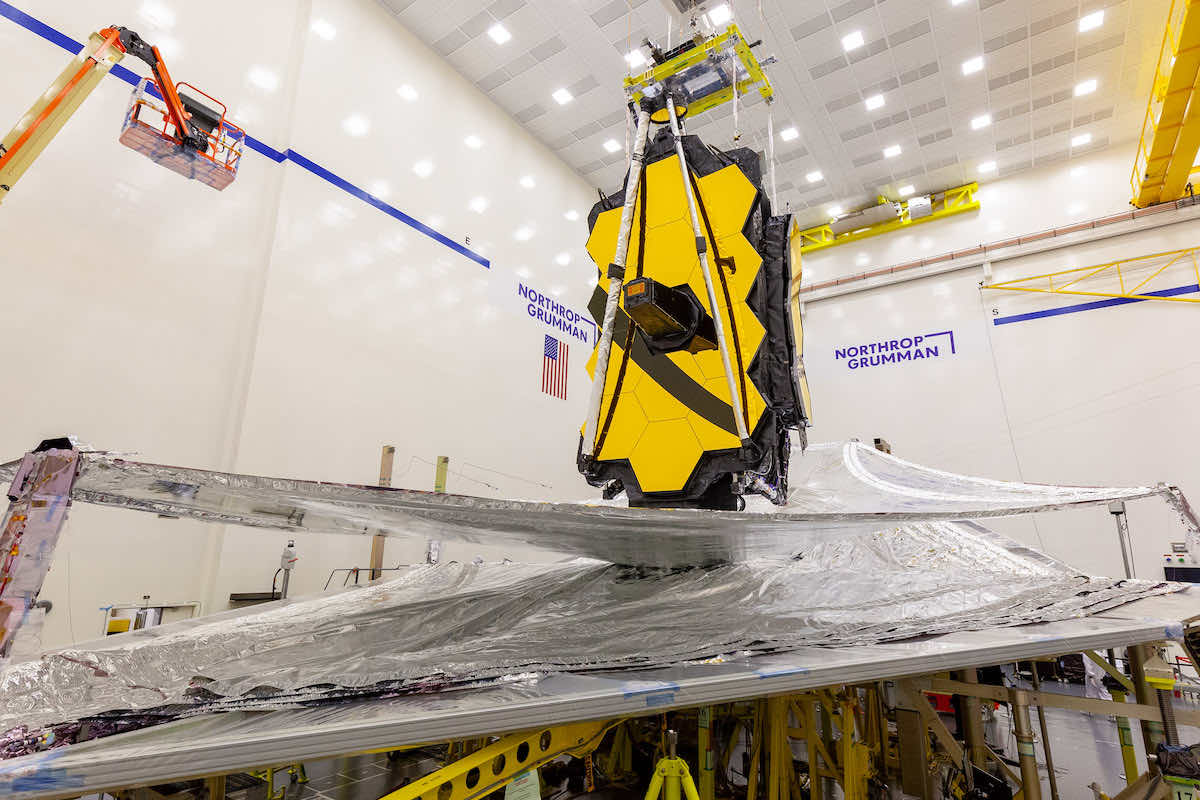Space News & Blog Articles
Engineers taking more time to assess Webb’s behavior in space before continuing deployments
STORY WRITTEN FOR CBS NEWS & USED WITH PERMISSION
 Northrop Grumman teams work with the sunshield on the James Webb Space Telescope during ground testing. Credit: Northrop Grumman
Northrop Grumman teams work with the sunshield on the James Webb Space Telescope during ground testing. Credit: Northrop Grumman
Engineers activating the James Webb Space Telescope decided Sunday to hold off tightening up the observatory’s critical sunshade to allow more time to check out the performance of its power systems and overall behavior now that several major deployments are complete.
“Nothing we can learn from simulations on the ground is as good as analyzing the observatory when it’s up and running,” Bill Ochs, the Webb project manager, said in a NASA blog post Sunday. “Now is the time … to learn everything we can about its baseline operations. Then we will take the next steps.”
NASA is not providing “live” coverage of Webb’s deployments and has not held a media briefing since the telescope’s launch on Christmas Day. But the latest blog post said engineers wanted to more thoroughly characterize the telescope’s performance now that it’s finally in space while making sure motors needed for sunshade tensioning are at the “optimal” temperatures before proceeding.
No technical details were provided.
Since launch on Christmas Day, Webb has successfully fine-tuned its trajectory with two precision thruster firings, deployed its critical solar panel, unlimbered the high-gain antenna it will use to relay science data back to Earth and extended a “momentum flap” to counteract the destabilizing pressure of the solar wind.
It’s also elevated its primary mirror and science instruments by about four feet to further isolate them from the heat generated by on-board electronics and other systems.
On Friday, two telescoping booms extended to either side of two pallets, pulling out and unfolding Webb’s tennis court-size sunshade to kick off one of the most complex procedures in the observatory’s initial activation.
Made up of five hair-thin Kapton layers, the sunshade is critical to Webb’s goal of capturing faint light from the first stars and galaxies to light up in the wake of the Big Bang birth of the cosmos nearly 14 billion years ago.
To register that ancient radiation, now stretched out into the infrared by the expansion of space itself, Webb must be chilled to within 50 degrees of absolute zero, or nearly 400 degrees below zero Fahrenheit. The light- and heat-blocking shield needed to do that, which was folded up for launch like a skydiver’s parachute, is now in the process of being extracted.
The two pallets holding the sunshade were deployed and locked in place Tuesday, one on either side of Webb’s 21.3-foot primary mirror. On Thursday, protective covers were commanded to roll off each pallet, exposing the still-folded sunshade membranes to space.
The actual deployment began Friday when the two telescoping booms at right angles to the pallets began extending, one at a time, slowly pulling out both sides of the shield and unfolding the membranes in the process.
That work started later than expected to give engineers time to confirm 107 membrane retention devices, used to hold the folded layers in place during launch, had worked as required.
They did, and with both booms extended to give the sunshade its iconic kite-like shape, all five layers must now be pulled taut using motor-driven cables running through scores of pulleys. Tensioning is required to produce a gap between each layer, providing space for excess heat to migrate outward to the sides.
Because the boom extension work took longer than expected, mission managers put tensioning on hold Saturday to give the team a chance to catch its collective breath. Another delay was ordered Sunday, in part to make sure the motors needed for the shade’s full extraction were at the required temperatures.
“We’ve spent 20 years on the ground with Webb, designing, developing and testing,” said Mike Menzel, Webb’s lead systems engineer. “We’ve had a week to see how the observatory actually behaves in space. It’s not uncommon to learn certain characteristics of your spacecraft once you’re in flight. That’s what we’re doing right now.
“So far, the major deployments we’ve executed have gone about as smoothly as we could have hoped for. But we want to take our time and understand everything we can about the observatory before moving forward.”
When you subscribe to the SpaceZE News Feed, we will send you an e-mail when there are new updates on the site so you wouldn't miss them.

